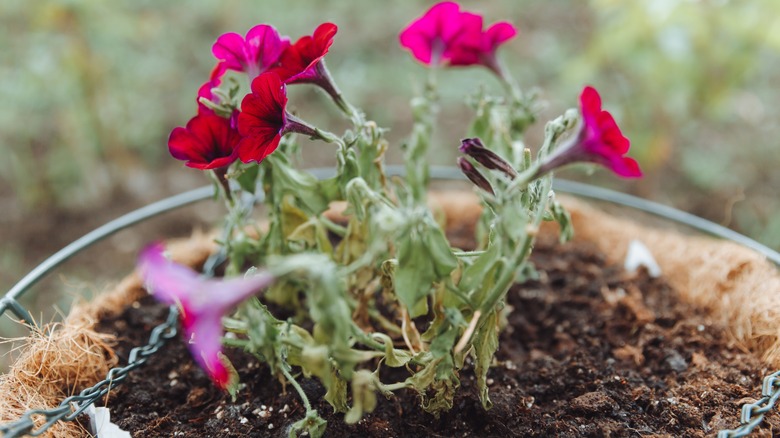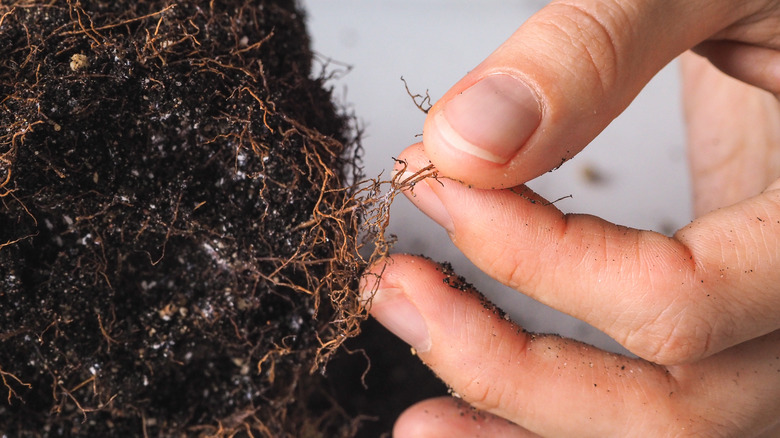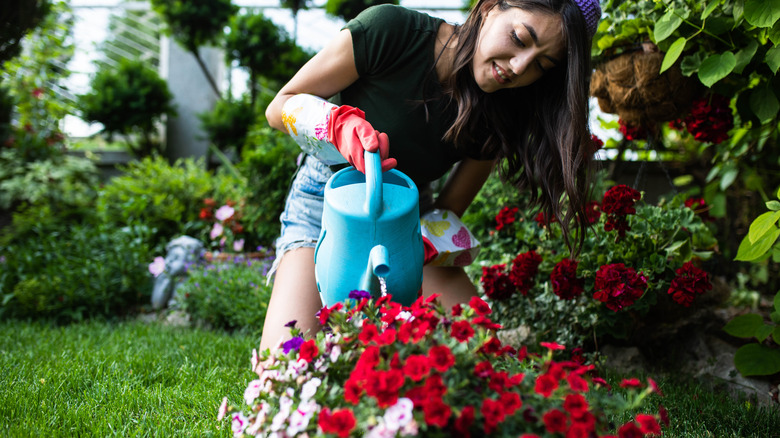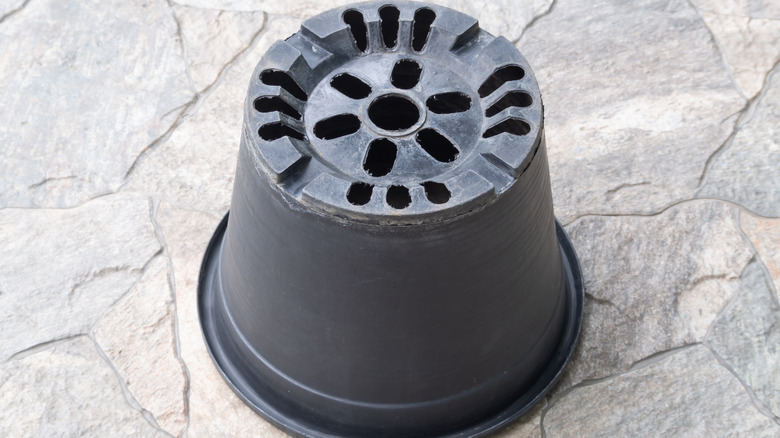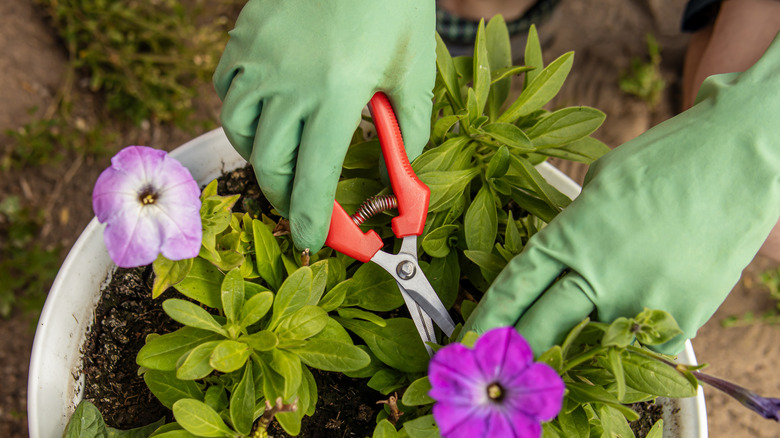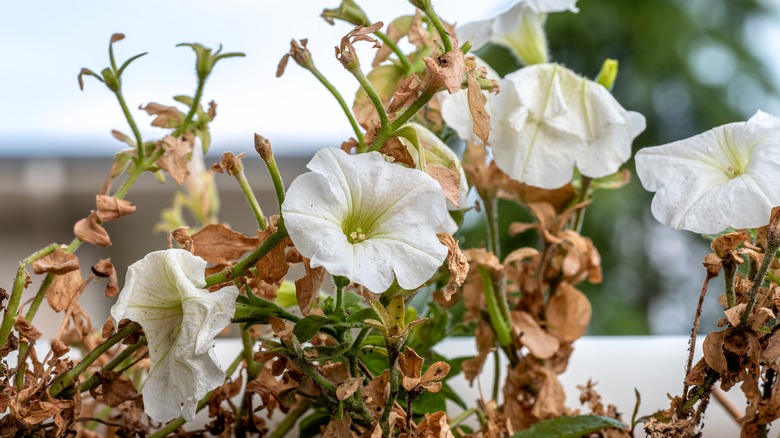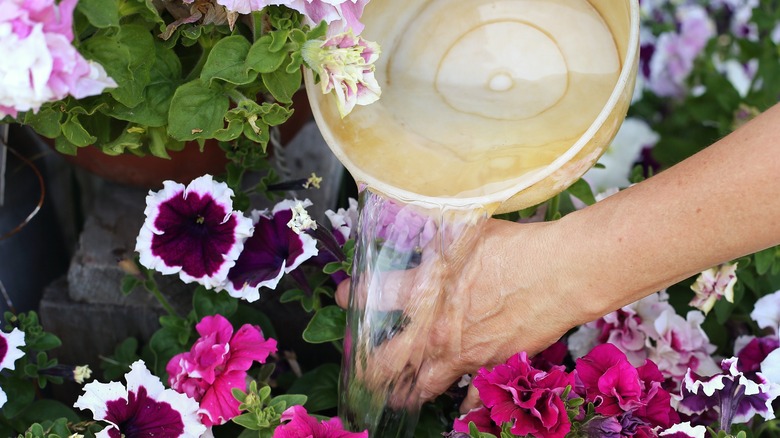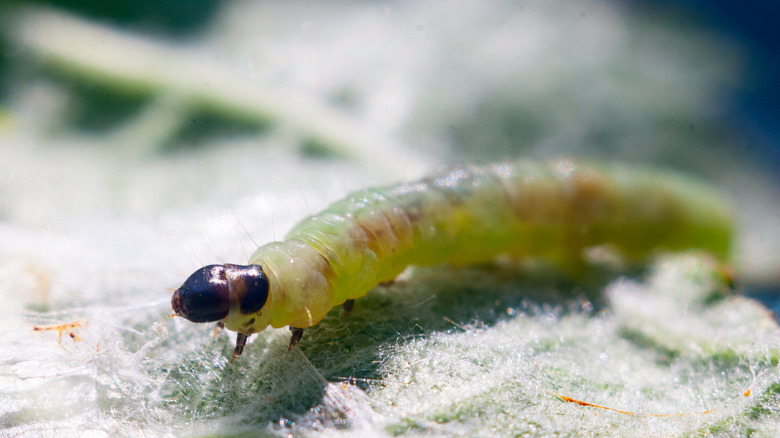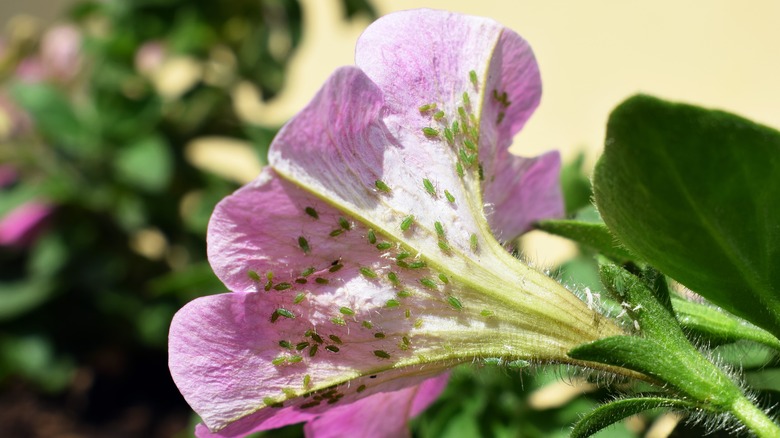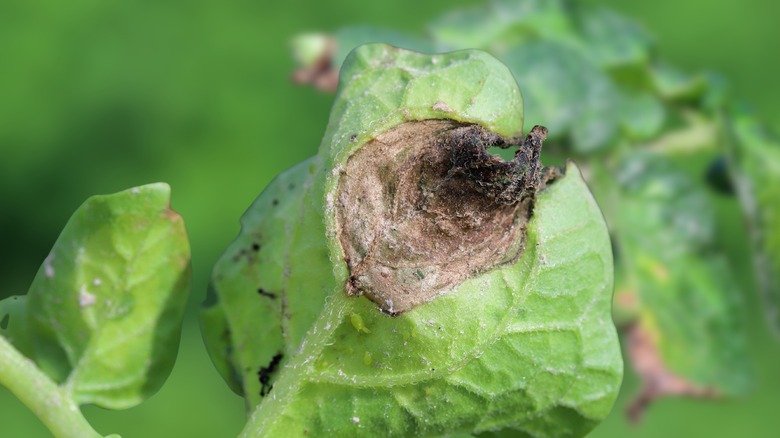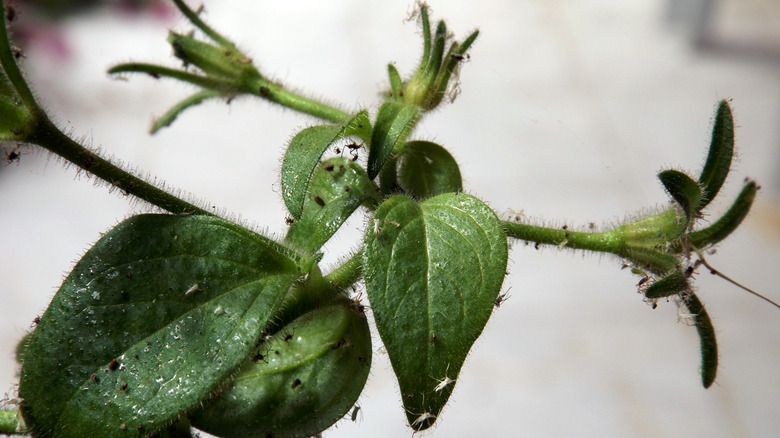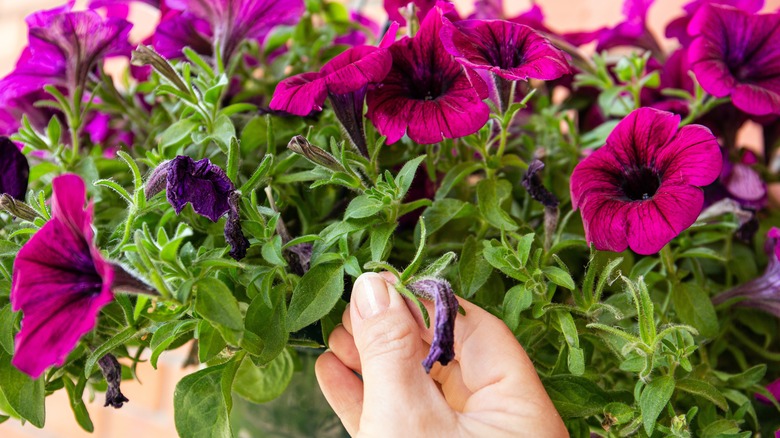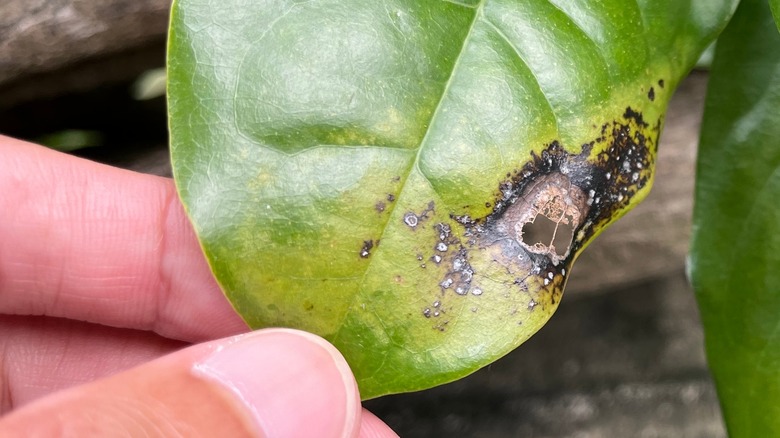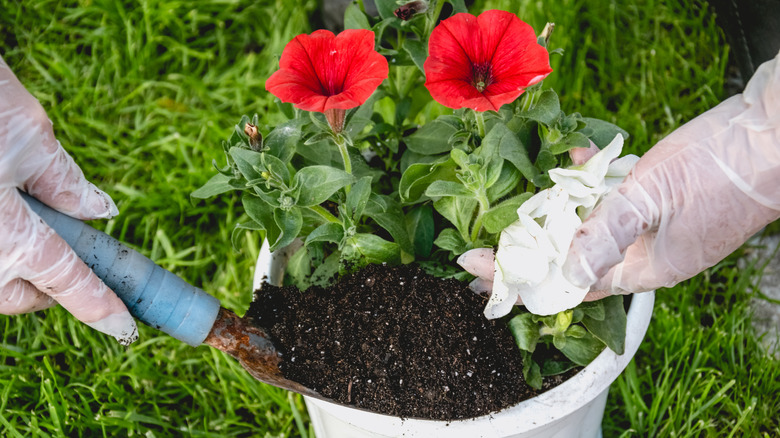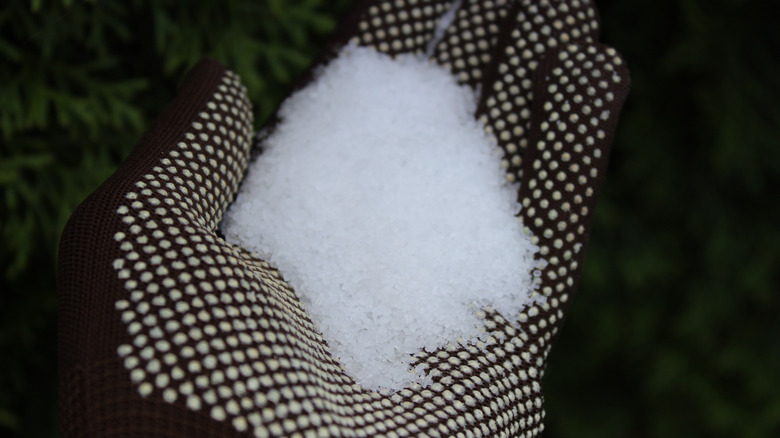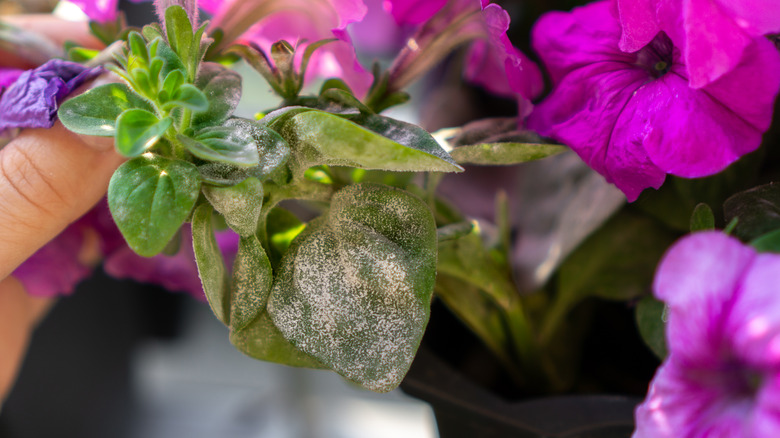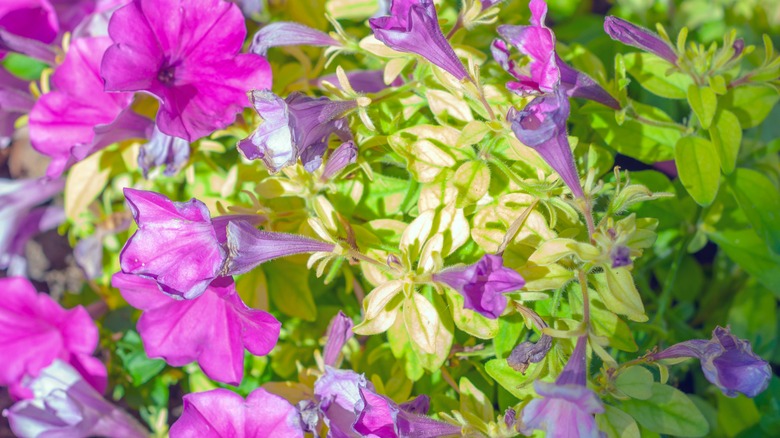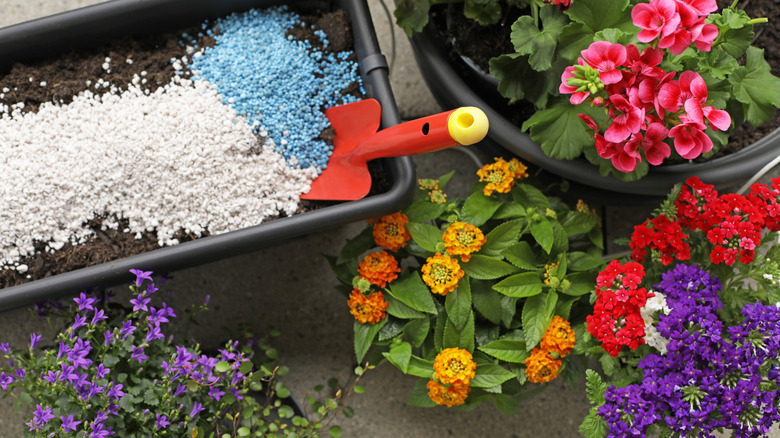17 Surefire Ways To Bring Your Dying Petunias Back To Life
We may receive a commission on purchases made from links.
Petunias are among the most versatile flowers. They offer a rich variety of shades and types, giving you more control over your garden aesthetic. Although they're a gardener's favorite due to their low-maintenance qualities, you'll want to avoid making some common mistakes that'll kill your petunias before summer's over. Like any plant, they have specific growth requirements and can suffer from various issues. If your petunias aren't doing as well as they could be, the first thing you need to do is make sure they're getting their basic needs met. They require at least six hours of sunlight daily, with some afternoon shade, and evenly moist, organically-rich, well-drained soil.
Even with the best care, you may notice wilted blooms, yellowing leaves, and other issues from outside factors. Petunias are susceptible to root rot, crown rot, Botrytis blight, and pests like mites, aphids, and budworms. If you notice your blooms are wilting, foliage is discolored, or they simply aren't growing as well as they once were, it's time to take action to bring your petunias back to life.
Remove mushy roots to help petunias bounce back from root rot
Root rot is one of the most common issues gardeners face and is often the result of overwatering. However, poor drainage, contaminated soil, or fungal pathogens can also cause this disease. Petunias with root rot may wilt, have yellowing leaves, and have an unpleasant odor. If you're unsure, the best way to check for root rot is to look at the roots themselves. Healthy roots will be firm and white, while unhealthy roots will be mushy and dark brown or black. Removing the decaying roots will help your petunias bounce back by halting the spread of the disease. It's also a good idea to trim back some of the foliage to allow the plant to focus its energy on rebuilding the root system.
Thoroughly examine the roots and use gardening shears to trim off all of the dead stuff. Once you're finished, only healthy, white roots should remain. Use 70% isopropyl rubbing alcohol to clean your shears after each cut and before removing any foliage to keep the fungus from spreading. Swap out the soil to an organically rich and well-drained blend. If your petunias are in a container, make sure there are plenty of drainage holes to avoid waterlogging. For bad infections, using a fungicide can help kill any remaining root rot left behind. Prevent future outbreaks by adjusting your watering schedule, only watering when the top couple of inches of soil are dry.
Fix wilted petunias by watering more deeply
Gardening can be tricky, especially when it comes to properly hydrating your flowers. Some gardeners mistakenly avoid deeply watering, thinking it'll prevent overwatering issues. However, not providing your petunias with sufficient moisture during watering sessions results in roots not receiving enough hydration to thrive. If your blooms look saggy or wilted, they may just need a large drink to perk up. Rather than sticking to a strict watering schedule, go by the way the soil feels. Watering petunias in the summer heat will look different than providing hydration in cooler months. They can be thirsty flowers that prefer evenly moist soil, so make sure they get adequate moisture, and don't let the soil completely dry out between waterings.
Petunias in containers will need more frequent watering than those growing in a garden bed, sometimes daily. Use a hose or watering can long enough to moisten all the soil, allowing excess water to drip out of the drainage holes. Spreading varieties, such as "Wave" petunias, may also need more frequent moisture whether in a bed or planter. Typically, most garden bed petunias won't need to be watered as often as the others, though periods of drought and excessive heat may call for an extra shower. When the soil feels dry, give your ground plants a deep watering, making sure that it soaks the soil 6-8 inches deep each time.
Correct drainage and water less frequently if your petunias have crown rot
Phytophthora crown rot is another disease often caused by improper drainage or overwatering. If your petunias have stopped blooming or growing, have discolored foliage near the crown, and have an overall lackluster appearance, it may be a sign that this fungus has taken over your plants. Without interference, crown rot can quickly kill off the entire lot of your petunias, causing them to wilt and die, often within weeks. Unfortunately, there aren't many fungicides or other chemicals capable of managing this disease, so your best course of action is to eliminate as much of the fungus as possible.
Holding back on watering and fixing any drainage issues are the only ways to save infected plants, though they may not recover. If there is an outbreak, it's typically best to remove the diseased plants and replace them with healthy petunias and clean soil. Transfer any uninfected petunias to fresh, organically rich, and well-drained soil. Remove and dispose of infected petunias and the old soil to prevent Phytophthora from being transferred to other plants. Never place diseased plants in compost, as the fungus will contaminate it. Moving forward, it's crucial to take prevention methods to avoid future outbreaks. You only need to water your petunias when the soil is moderately dried out. Inspect the foliage and roots of new plants for signs of disease before purchasing and planting in your garden.
Prune and deadhead to restore life in dull or dying petunias
The combination of dead blooms, leggy growth, and yellow leaves could make you worry that your petunias are on the brink of death. If your petunias aren't putting out new blooms like they usually do or have an overall dull appearance, it may be time to give them a trim. Deadheading and pruning are essential maintenance tasks to keep petunias looking and feeling their best. You'll likely need to cut back your plant three times each year: early July, mid-August, and mid-September. However, you'll need to deadhead spent blooms regularly.
Use a sharp, sanitized pair of scissors to remove any faded blooms, cutting the stem at the base of the flower. Pinching them off with your fingers also works. Regularly deadheading spent flowers allows the plant to focus on producing new blooms rather than seeds and extends the blooming period. Lightly prune your petunias in the first couple of weeks of July, focusing on leggy branches to encourage new growth. Repeat this process in the middle of August, making sure you don't remove more than 1/3 of your plant. By mid-September, your petunias will likely require their final trim. If you notice long, unsightly stems or your flowers aren't looking their best in general during the growing season, sometimes all they need is a nice haircut to bounce back.
Fertilize more often if your petunias have leaf curling and browning
Petunias tend to be easy-going, but they're heavy feeders that likely need more food compared to other flowers. Regular fertilization will ensure you enjoy more vibrant blooms and achieve optimal plant health. Although a balanced fertilizer works, petunias benefit from extra potassium and phosphorus during their growth season. Leaf curling or browning foliage are signs that your petunias are potassium deficient. If they're due for another round of feed, they could also have an overall dull appearance or decreased blooming. If it's been a while since you've fed your petunias or you're using a blend that doesn't have the ratio of nutrients they need, it may be time to apply fertilizer or make adjustments.
The general rule of thumb is to apply a liquid fertilizer every 3-4 weeks during the blooming season. Slow-release fertilizers are a good option for container plants, and they're also a solid choice for more laidback gardeners. However, similar to watering, it's best to listen to what your petunias tell you rather than following a strict fertilization cycle. Spreading petunias may require weekly fertilization, and any variety may benefit from more frequent feeds. Because petunias can't talk, you'll need to look for signs that they need a boost. It may take a little experimentation before you discover the best nutritional blend and feeding frequency for your unique plants. If your petunias look worse after fertilization, hold back on feeding; you don't want to overdo it either.
Flush the soil to revive overfertilized petunias
Petunias may be hungry plants that require a lot of fertilization, but that doesn't mean you can't feed them too much. Overfertilization is a common mistake for gardeners eager to get more flowers out of their petunias, only to cause wilted blooms and damaged foliage. You'll know you've overdone it if your plants look worse after applying the feed, often exhibiting yellowed leaves, brown leaf tips, and saggy blooms. For your petunias to heal, you'll need to remove as much fertilizer as possible. Whether your petunias are potted or growing in a garden bed, flushing with water is the best way to transfer the remaining nutrients away from the damaged roots.
Use a shovel to remove any visible feed (the white, crusty layer), even if it means you have to dispose of a good chunk of topsoil. Heavily water container plants, letting the excess feed and moisture drain from drainage holes. Soak ground petunias with a hose or sprinkler for about 30 minutes until the soil looks soggy, and give it a few days to drain through. Depending on the extent of the remaining damage, you may need to repeat this process when the soil is moderately dry. However, it may take a bit to see a positive change. Add a fresh layer of topsoil to replace what was removed. Trim off overly damaged leaves, making sure you don't remove more than 2/3 of the plant. In extreme cases, transplanting may be the best option for recovery.
Use Dipel to eliminate budworms attacking your petunias
Although tobacco budworms are sometimes known as geranium budworms, they're also big fans of petunia plants. Holes appearing in flower buds are a good sign these caterpillars have been munching on your plant. You also may notice some bites taken out of the petals or peppery-looking droppings left behind. Because they feed at night, you likely won't know you have them until they've already done their damage. If you do catch a glimpse, you'll notice brown, green, red, or purple caterpillars that are up to 1 3/4 inches long hanging out on the base of your plant. When these pests use your petunias as their nutrition source, they cause damage to the buds, leaving them unable to open.
Frequently monitor your petunias for early signs of infestation to prevent budworms from wreaking havoc on your blooms. If you notice any signs of an infestation, apply a product that specifically targets caterpillars, like Dipel Dust. This non-toxic solution is easy to apply and attacks budworms from the inside out when they go to nibble on your plants. All you need to do is sprinkle the powder across the flowers, foliage, and stems, and the Dipel will do the rest. You can use this product on any plants suffering from damage from several species of caterpillars, too.
Kill aphids on your petunias with your garden hose
Houseplant connoisseurs and avid gardeners have a common enemy: aphids. These sap-sucking pests are in most gardens, though a few of them hanging around aren't typically a cause for concern. Unless there's an infestation, you likely won't notice them at all. Unfortunately, with the right conditions, these tiny insects can quickly multiply and attack your plants. The first signs of aphids on your petunias are yellowed, twisted, and curled leaves or stunted plant growth. When an infestation isn't dealt with, they will quite literally suck the life out of your petunias. Thankfully, all you need is an ingredient you're likely already using: water. It's best to avoid pesticides if possible because aphids attract beneficial insects that you do want hanging around your garden.
To get rid of aphids, use your garden hose to blast them off your petunias. While your petunias are strong enough to withstand the water pressure, aphids struggle to hold on. Because of this, it's possible you'll see more of these small bugs during periods without a lot of rainfall. You may have to repeat this process a few more times to make sure all of the pests are gone. As the adults fall off your plants, the "good insects" will likely come by and eat the aphids. Once the rain has washed away all the little bugs, it's time to give your petunias a good trim. Remove all of the dead stems and leaves to allow new, healthy growth.
Apply calcium chloride spray to save petunias affected with Botrytis blight
Botrytis blight, also known as gray mold, is a fungal condition that can be detrimental to petunias and other plants. An infection could cause abnormal flower development and discoloration, and soft, brown patches on the foliage. It will start by invading damaged tissue, but once inside, it can quickly take over healthy leaves, stems, and blooms. While fungicides may help slow the spread of the disease, botrytis can become resistant to the applications. According to a study performed by members of the Agricultural Research Service of the United States Department of Agriculture, calcium chloride treatment could help revive plants infected with botrytis blight. It works by protecting the plant by strengthening its cell walls, making it harder for the fungus to break them down. It's also theorized that the salt content aids in destroying the fungal cells.
As botrytis blight takes over, plant parts will fall off, taking the spores with them. If you don't get it under control quickly, this disease could transfer to healthy plants in your garden. Before disposing of plants with early infection, it may be worth giving a calcium chloride treatment a try. Dayton Nursery recommends mixing 2½ Tbsp of calcium chloride ice melt into 2 gallons of water. Spray an even coat over the entirety of your petunias, making sure you get the leaves, stems, and flowers. Repeat this process every two weeks during the growing season to help prevent and eliminate botrytis.
Use neem oil to combat petunia-loving mites
Cyclamen mites, spider mites, and other pests in the Tetranychidae family commonly feed on petunia plants. Because they're so tiny, it can be hard to spot them with the naked eye. Instead, if your petunias appear dusty or have fine webs on the underside of their leaves, it's a good sign that you may be dealing with these small arachnids. You may also see plant damage like distorted foliage or discolored and spotted leaves. If you spot any of these indicators, it's time to turn to a natural solution that kicks spider mites to the curb. Neem oil is a thick, non-toxic substance that kills mites on contact. The heavy liquid coats their bodies, causing them to suffocate and die. While it won't work on all plant pests, it's effective against several types of mites.
Neem oil is widely available at a variety of retailers. For example, Bonide Captain Jack's Neem Oil is a highly-rated option you can purchase on Amazon. Use this spray liberally all over your petunias. Make sure to get into each nook and cranny, paying special attention to the underside of leaves where they tend to hang out. Repeat this process at least once each week until the infestation is cleared out. Neem oil can eliminate several other types of pests, like mealy bugs, thrips, aphids, and more. So, it's a good product to always have on hand as a gardener.
Pinch off petunias wilting from temperature changes
Petunias can be a little bit dramatic when the temperature isn't exactly how they like it. They're happiest when it's between 65 and 80 degrees Fahrenheit, and abrupt temperature changes can cause them to wilt, have stunted growth, or die back. Unfortunately, there isn't much you can do to control the weather, but there are steps you can take to keep them healthy during extreme hot and cold conditions. Paying attention to the thermometer and taking precautions is key, but sometimes mother nature changes on a whim. If your petunias are drooping or have leaf burn, removing the dead parts and giving them a drink of water is the best course of action.
If the heat causes damage to your plant, prune off any burnt or dying leaves and stems, and pinch off wilted flowers. Give them plenty of water on particularly hot days to help prevent heat stress. Don't use cold water as it can shock their roots. If potted, it may help to move them to an area of your garden that receives some shade during the hottest parts of the day. You can also add shade over your plants, like an umbrella, until you get through the heat wave. It's also important to provide proper care for petunias if temperatures dip. A frost cloth will help keep them warm on chilly nights. Mulch is also a great way to regulate soil temperatures, whether it's hot or cold outside.
Improve air circulation for petunias with bacterial leaf spot
Bacterial leaf spot is a disease that often affects petunias, especially those in humid environments with poor air circulation. It's caused by bacteria that primarily spreads through water droplets but can be transferred through wind, infected plant parts, or contaminated soil. Petunias suffering from this disease may show water-soaked leaves with brown spots, large, rotten patches, and yellowing near the darkened area, usually starting at the base of the plant. If not treated, your petunias may have stunted growth or even die. Pruning is the best course of action because not only does this remove the infected parts, but it also helps increase air circulation, helping to manage this disease.
Use sterilized gardening shears to remove any infected leaves and stems. Because this disease thrives in plants with poor airflow, you may want to remove a little extra foliage to help with circulation. Use rubbing alcohol to clean the blades in between cuts so that you don't reintroduce the disease to healthy parts of your plants. Make sure the infected leaves and stems are disposed of in the garbage; plant debris with spots will contaminate compost. Follow up with a bactericide, like this Monterey Complete product from Amazon, to stop any remaining bacteria in its tracks. Moving forward, always make sure to plant petunias at least 12 inches apart to promote proper air circulation. Avoid overhead watering, and only water in the morning so that water droplets don't sit on the foliage for long periods.
Trim back petunias struggling with transplant shock
At some point, you may want to move your petunias from a container to the garden. While there's nothing wrong with relocating your petunias, the change in environment could cause some distress. Symptoms of transplant shock include wilted blooms or foliage, leaf shedding, stunted growth, or overall poor plant health. While there isn't any surefire cure to treat this condition, there are some steps you can take to help your petunias bounce back. Even if you're careful, it's nearly impossible not to damage and even remove some of the roots when you take a plant out of the soil. Trimming your petunias will allow your plant to focus its energy on establishing new root systems.
To help bring your petunias back to life, start by removing about 1/3 of your plant. If your petunias are in an area with full sun, you may need to give them some shade for a few days to help them slowly adjust to their new environment. Be even more diligent about watering your petunias, making sure the root ball is always moist. It may take a bit of time for your petunias to get back to their vibrant selves, so be patient while they settle into their new home.
Try adding Epsom salt to petunias that aren't growing
You've given your petunias plenty of love and care, making sure they have everything they need to thrive. Yet, they still aren't growing as well as they should be. What's the issue? Depending on the symptoms, your plant could be struggling with a sulfur or magnesium deficiency. As we talked about earlier, petunias need several nutrients to thrive. Yellowing leaves or interveinal chlorosis may signify your petunias need a dose of magnesium, and yellowish-green leaves could indicate a lack of sulfur in their diet. Epsom salt combines the best of both worlds, being rich in these nutrients. However, it's crucial to test your soil before applying this treatment. Too much magnesium could cause more harm than good to your petunias.
Use a soil nutrient testing kit, such as this one on Amazon, which includes readings for magnesium and sulfur. If the results indicate your soil is deficient in these nutrients, Epsom salt may be the solution to your problems. Start by dissolving 1 tablespoon of Epsom salt into a gallon of water. Water your petunias with this solution when the soil is ready for another watering. Monitor your petunias for signs of improvement. If they haven't perked up, you may need to repeat this process a month after the initial application.
Treat powdery mildew with potassium bicarbonate
Powdery mildew is another disease that thrives when petunias receive poor air circulation, and it favors warm, dry conditions. As the name suggests, this condition is characterized by powdery white blotches on stems, leaves, and flowers. In severe cases, the fungi may completely cover the leaves. Although unsightly, it's rarely fatal to your petunias, though it can cause a wide array of issues like decreased blooming, stunted growth, and yellowing leaves. A baking soda mixture is sometimes a recommended treatment, though it works better as a preventative measure. Research conducted by the Wageningen University & Research Centre concluded that potassium bicarbonate is highly effective at treating plants struggling with powdery mildew. It works by altering the pH level on the leaf surface, which becomes more alkaline and consequently slows the growth of the fungus.
To prevent powdery mildew from taking over your garden, combine a tablespoon of potassium bicarbonate and 1/2 teaspoon of liquid dish soap into 1 gallon of water. Spray this solution all over the leaves and stems, making sure to cover any infected areas thoroughly. Like watering, it's best to apply the treatment in the morning to prevent leaf burn. Repeat this process as needed. Make sure your plants are properly spaced and regularly pruned to promote better air circulation, making them less susceptible to obtaining the fungus in the future.
Discard petunias with tobacco mosaic virus or aster yellows
Tobacco mosaic virus (TMV) or aster yellows are two petunia-affecting diseases that you don't want to mess with. Unfortunately, both of these conditions are incurable, making it impossible to save plants infected with them. TMV is known for attacking tobacco plants, though it can target several ornamental species. This disease spreads through sap and can be transmitted through infected garden tools and anyone who touches an infected plant. It can also live in items like cigarettes and cigars, so wash your hands before tending to petunias if you use tobacco products. The symptoms include mosaic patterns on the leaves, yellow streaks or spots on the leaves, or yellowed veins. Aster yellows, on the other hand, spreads through Aster leafhoppers. Signs of this disease include yellow or white leaves, smaller or malformed blooms, and stunted growth. Unlike plants infected with TMV, yellowing leaves will have green veins on plants with aster yellows.
Because these diseases can spread to other plants in your garden, it's vital to remove and dispose of them appropriately. Remove every part of your petunias and place them and the soil they grew in into plastic bags. You should also get rid of any weeds in the immediate area as they could hold onto either disease and transfer it to healthy plants. Pesticides may be necessary to eliminate disease-carrying leafhoppers. With TMV, you'll need to be extra cautious because your clothing and tools can spread the virus to other plants.
Use fish fertilizer to revive crispy blooms
Fish fertilizer is exactly what it sounds like: fertilizer made from fish remnants. While this may sound odd, these underwater creatures contain the essential nutrients required for petunia growth, like nitrogen, phosphorus, and potassium. It also contains amino acids, proteins, magnesium, calcium, sulfur, sodium, and chlorine, all of which greatly promote plant health. If you can get past the fishy smell, it may be worth a try to give your crispy blooms a boost. The bonus nutrients in fish fertilizer can help plants recover more quickly from damage while strengthening their cell walls. This fishy liquid also makes your soil healthier by feeding microbes living in the dirt. These microbes convert substances that plants can't digest into forms that are easily absorbable, enhancing the overall nutrient uptake of your plants.
Like any feed you give your petunias, there can be too much of a good thing. Giving your plants too much fish food can lead to plant burn and damage. Most fish fertilizer is concentrated, so read the instructions closely before applying it. Generally, you should add 1/2 ounce of fish emulsion to a gallon of water to dilute the solution. It's recommended to apply the mixture to your plants twice per week, but like with trying anything new on your petunias, monitor them closely and adjust accordingly. Because crispy blooms are often a result of too much direct sun, you may also need to relocate them to a spot with afternoon shade.
